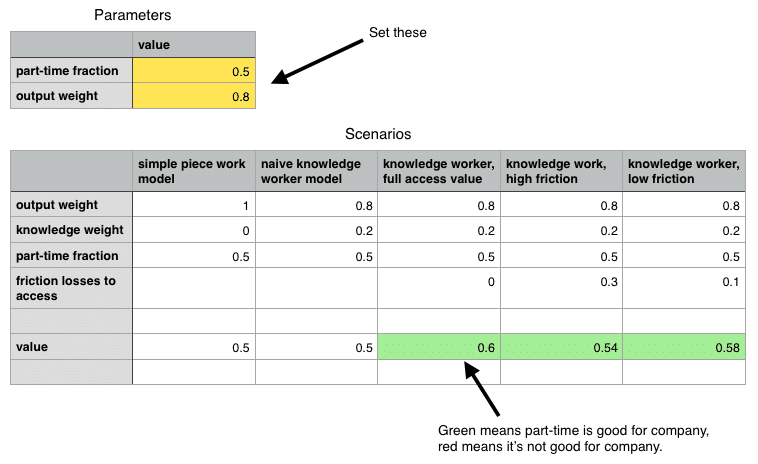In a world of talent scarcity—certainly the one software design and development companies live in currently—it would be foolish to not accommodate a proven employee’s request to move to a part-time schedule if the job allows it.
I think the value equation for part-time knowledge workers is usually favorable toward the company. Presuming part-time work is desired by an employee, this should be a win-win situation.
A Simple Model
I made a simple model to think through this question of value. I started from a simple piece work model, i.e. not that of a knowledge worker. This person’s entire value to the company is based on their output, not their knowledge. I doubt there are many jobs left like this in the US, but it’s an interesting case to consider.
In my model, when you change a piece work job to part-time, the output you get is scaled by the fraction of time worked. So for example, output is 50% of full-time if the job is a half-time job. The value exchange is even—half the pay for half the output.
My simple model assumes that pay and benefits are scaled with the fraction of part-time, and ignores overhead expenses like rent, utilities, etc.
The value to a company of a knowledge worker has two components: output and access. The access component represents the value the company gains from being able to access the experience, insights, creativity, cultural contributions, tribal knowledge, historical relationships, perspectives, and accumulated knowledge of the employee.
A naive model for calculating the value of a part-time knowledge worker is to scale both the output and access components of value by the fraction of part-time work. As the spreadsheet shows, that results in a fair exchange of value. I call this a naive model because I don’t believe the access component of value of an employee is scaled by going part-time. If the company maintains a relationship with a valuable, proven employee, the company should be able to continue to take advantage of all the elements of value I label as access.
The third scenario in the spreadsheet shows that in fact the value to the company is actually greater than the scaled pay received by the employee. This is because while the output value scales with hours, access value does not—it is fully retained by the company.
There might be some friction, however, in tapping the access value of a part-time person. I’m thinking of cases when access value is lost because of lack of serendipitous interactions or spur-of-the-moment needs. I modeled this with two scenarios. The first is high friction (30% of value lost) and the second is low friction (10% of value lost). In both cases, the company still gets a good deal. The value delivered is greater than the pay.
With output weight at 80% and access weight at 20%, the only part-time scenario in which the company receives less value than it pays for is part-time fractions greater than 75% and high friction. The results aren’t dramatically different if output weight is 90% and access weight is 10%.
Real-world Complexities
Pay is generally easy to scale. Benefits can be difficult, in my experience. Some of our benefits have requirements that make part-time employees ineligible. These make my model too gloomy from the company’s perspective. We also don’t have a mechanism in place for charging different workers varying amounts for benefits, so that makes my model too rosy.
Overhead expenses don’t scale with part-time, and they aren’t charged directly to employees. These make my model too rosy for the company.
A very important consideration is the nature of the work being done by a part-time person. Some knowledge worker jobs might actually require full-time to be effective. With all the electronic communication available today, however, flexible employees can probably succeed part-time in jobs that previously would have required full-time commitment.
My argument for the benefit to the company is based on retaining access to all the knowledge, skills, experience, relationships, etc, of the part-time employee. That’s a much stronger argument, to me at least, if the person has worked for us for years and is shifting to part-time. I think it would be riskier to start a new employee in a part-time mode.
The model
The links below are to Excel and Numbers.app versions of my simple model.
PartTimeWorkModel in Numbers.app
PartTimeWorkModel in Excel (ugly)
- Attention: Spending Your Most Valuable Currency - February 10, 2022
- Slicing the Revenue Pie in a Multi-Stakeholder Company - July 30, 2021
- Commercial versus Existential Purpose - July 19, 2021
- How I Misunderstood Mentorship and Benefited Anyway - June 16, 2021
- Sabbath Sundays and Slow Mondays - June 4, 2021
